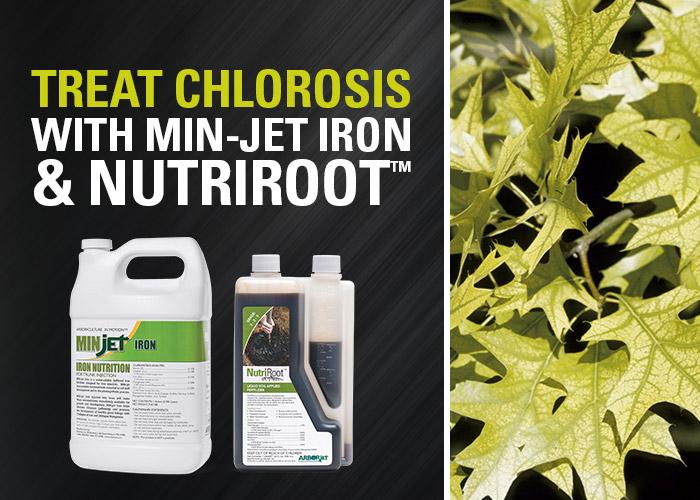Iron or manganese chlorosis describes a condition in which a tree’s foliage loses its healthy green color and fades to a pale green or yellow hue. Without treatment, this condition will cause slow growth, leaf loss, and eventually tree death. Chlorosis is often caused by deficiencies of the micro-elements iron and manganese, and is particularly prevalent in oak. In alkaline soils, iron and manganese become insoluble and unavailable to the tree. Trees growing in poorly drained soils are also susceptible to iron chlorosis. Arborjet recommends a two-pronged approach to treating foliar chlorosis, detailed below.
Symptoms & Treatment Recommendation
The primary symptom is the fading of the leaf color from green to increasingly paler shades of green and, when extreme, to an almost yellow tone. For treatment of iron or manganese chlorosis, we recommend the use MIN-jet Iron followed by NutriRoot™.
Enhance Tree Health Rapidly with MIN-jet Iron.
By quickly providing the minerals the tree needs, it is able to respond rapidly and generally will have darker, healthier leaves within weeks of application. MIN-jet Iron not only works for iron chlorosis caused by iron deficiency, but is also a good choice for general tree nutrition. Trunk injecting minerals makes them immediately available for use by the tree to enhance health, growth, and development. The trunk injected formula helps to promote development and function of roots, stem, and foliage in hardwood trees, providing water soluble, organic chelates of iron, manganese, zinc, boron and copper sulfate to promote healthy leaf function.
The NutriRoot™ Nutrient Package & Water Management System
NutriRoot™ is a unique two-component formulation of a nutrient package and water manager in one, providing a single solution for managing drought stress, reducing watering, and accelerating root growth. The nutritional supplement includes humic acid, kelp, and micro-nutrients designed to enhance soil conditions for accelerated root development. NutriRoot makes watering more efficient, reduces plant stress, and increases water storage in plants. Arborjet recommends a supplemental follow-up application of NutriRoot, which should be applied as a soil drench.
Treatment & Recovery
The best time to treat is in the fall, following leaf coloration for foliage responses in the following growing season. When treating in the early spring or summer, use the lowest label rates and always use the lowest label rates when treating birch trees.
Recovery will be proportional to the level of the severity of chlorosis at the time of treatment. Response to treatment can be very rapid; you can expect to see noticeable greening and improved vitality within the growing season and often within weeks of application. Tree responses vary with soil conditions. Calcitic soils with little organic matter require comprehensive approach to treatment, including soil amendments.
Do you have questions about chlorosis, NutriRoot™ or MIN-jet Iron? Contact us!

